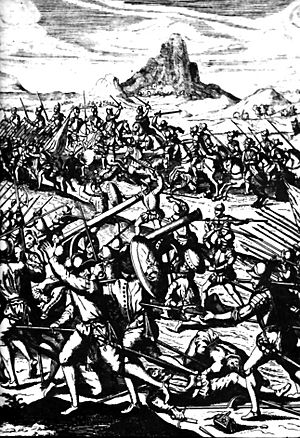Gómez de Alvarado facts for kids
Quick facts for kids
Capitán
Gómez de Alvarado
|
|
|---|---|
| Birth name | Gómez de Alvarado y Contreras |
| Nickname(s) | El Viejo |
| Born | 1482 Badajoz, Crown of Castile |
| Died | September 1542 (aged 59–60) Vilcashuamán, Viceroyalty of Peru |
| Allegiance | |
| Years of service | 1510–1542 |
| Battles/wars | Spanish colonization of the Americas |
Gómez de Alvarado y Contreras (born 1482 – died September 1542) was a Spanish conquistador. A conquistador was a Spanish explorer and soldier who helped conquer lands in the Americas. Gómez was part of the important Alvarado family. He was also the older brother of the well-known conquistador Pedro de Alvarado.
Gómez de Alvarado joined the Spanish efforts to settle the Americas starting in 1510. He was a captain in the cavalry, which means he led soldiers on horseback. He fought in Spanish campaigns against the Aztec Empire and the Maya people in Guatemala and El Salvador. He also took part in the conquest of the Inca Empire. In 1539, he helped found the city of Huánuco in Peru. He became sick and died in 1542, shortly after a battle.
Early Life and Family Background
- Further information: Alvarado family
Gómez de Alvarado y Contreras was born in 1482. His birthplace was Badajoz, in a region of Spain called Extremadura. He came from the Alvarado family, which was famous for its conquistadors. His parents were Pedro Gómez de Alvarado y Mexía de Sandoval and Leonor Contreras Carvajal y Gutiérrez.
Gómez had several brothers and sisters. His brothers were Jorge, Pedro, and Gonzalo. He also had a sister named Sarra. Gómez married Bernardina de Frias. They had two daughters, Isabel and Ana.
Adventures in New Spain
In 1510, Gómez de Alvarado left Spain for the Americas. He traveled with his brothers Jorge, Pedro, and Gonzalo. Their uncle, Diego de Alvarado y Mexía de Sandoval, also joined them. They served under Hernán Cortés during the Spanish conquest of the Aztec Empire. This was a major event where the Spanish took control of the Aztec lands.
On December 6, 1523, Pedro de Alvarado led an army from Tenochtitlan. Gómez was part of this group. They went to what is now Guatemala. This marked the start of the Spanish conquest of Guatemala. This conquest continued for many years.
By the end of 1524, Gómez, Pedro, and Jorge began exploring El Salvador. They started the conquest of a region called Cuzcatlan. In a battle known as the Battle of Tacuzcalco, Gómez led twenty cavalrymen. They fought against one side of the native army. During this time, the city of San Salvador was founded. This happened on April 1, 1525.
Campaigns in Peru

In 1532, Pedro de Alvarado left Mexico to join Francisco Pizarro. Pizarro was leading the Spanish conquest of the Inca Empire in South America. Gómez joined them in 1534. Before this, Gómez had served as the mayor of San Salvador from 1532 to 1534. In Peru, Gómez served under another Spanish leader, Diego de Almagro.
In September 1536, Gómez commanded 90 cavalrymen. They helped the Spanish win the Battle of Reinohuelén. This battle was against native forces.
Later, a civil war started between the forces of Pizarro and Almagro. This happened in 1537. Gómez sided with Almagro. He took part in the Battle of Abancay on July 12, 1537, where Almagro's side won. However, Gómez was captured during a defeat at the Battle of Las Salinas in April 1538. He refused to give his sword to a Spanish soldier. Instead, he gave it to an African slave. After Almagro was executed, Pizarro pardoned Gómez.
Gómez de Alvarado then founded the city of Huánuco in Peru in 1539. The city was later moved and rebuilt in 1541.
Pizarro was killed in June 1541. This led to a second civil war in Peru. Gómez de Alvarado fought under Almagro's son, Diego de Almagro II. Their army fought against Cristóbal Vaca de Castro's forces. This battle was called the Battle of Chupas. Almagro's side lost the battle. Many of their soldiers were captured and executed.
Gómez managed to escape capture after the battle. However, he became very ill with a fever. His health quickly got worse. He died a few days later in September 1542. He passed away in the town of Vilcashuamán. His body was moved to Huamanga, where he was buried.
See Also
 In Spanish: Gómez de Alvarado y Contreras para niños
In Spanish: Gómez de Alvarado y Contreras para niños

